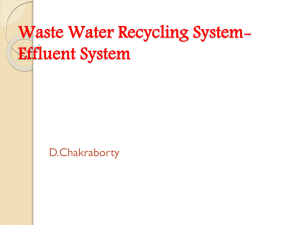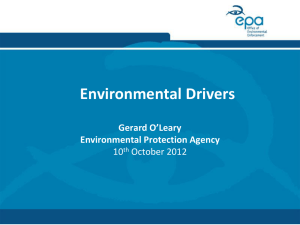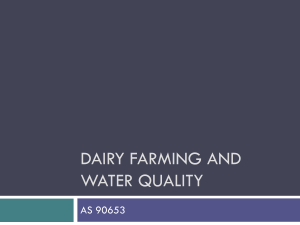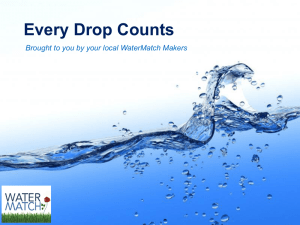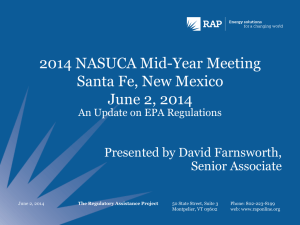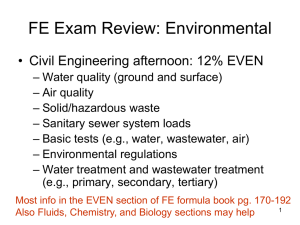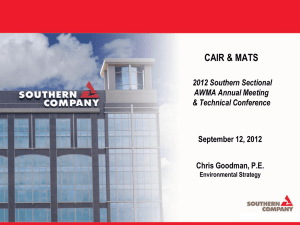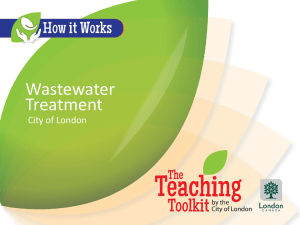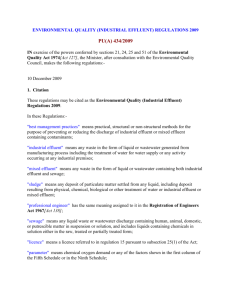Trade Effluent Charges & Mogden Formula Tool Explained
advertisement
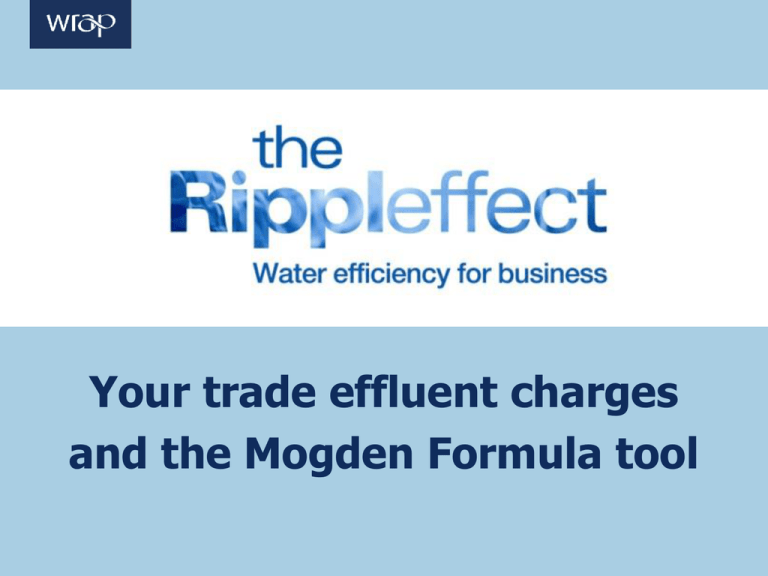
Your trade effluent charges and the Mogden Formula tool What is trade effluent? Trade effluent Trade effluent is any liquid waste (effluent) that is discharged from premises being used for a business, trade or industry. Trade effluent can be discharged from both large and small premises, including businesses such as car washes and launderettes. You must always get a trade effluent consent or enter into a trade effluent agreement with your water and sewerage company before you discharge trade effluent to a public foul sewer. For further information visit the following business websites: England - Business Link: Environment and efficiency Northern Ireland - NIBusinessInfo: Environment and efficiency Scotland - Business Gateway: Environment and efficiency Wales - Business.Wales.gov.uk: Environment and efficiency Trade effluent Trade effluent is wastewater which may be contaminated with materials such as: heavy metal rinses fats, oils and greases solids chemicals food wastes detergents The only liquid wastes which are not classed as trade effluent are: domestic sewage clean, uncontaminated surface water, i.e. clean rainwater which has not been contaminated when running over your site. How are trade effluent charges calculated? Trade effluent charges Trade effluent charges are based on the Mogden Formula. Your trade effluent service provider uses the Mogden Formula to recover the cost of carriage to and treatment of your trade effluent at their treatment plant (sewage works). The scale of your effluent charge depends on factors such as its ‘strength’ and volume. Component costs are revised each year in April. Check your trade effluent bill to see what charges apply. Trade effluent charges Trade effluent volume may be metered or based on calculations (i.e. your water use less your non-return to sewer allowance). Non-return to sewer allowances include ‘losses’, e.g. from nonrecovered steam, evaporative losses from cooling towers and water used as product make-up. For further information refer to leaflet EN664 Understanding water and wastewater bills which you will find in the Module Resources section. The Mogden Formula Charge (p/m3) = (R + V + Bv + M + B x Ot + S x St) x volume Os Ss R = reception and conveyance V = primary treatment 8.77 - 62.9 p/m3 10.76 - 52.68 p/m3 Bv = additional biological treatment (p/m3) M = marine (where effluent goes to sea) (p/m3) B = BOD of settled sewage 10.94 - 92.75 p/m3 S = treatment and disposal of primary sludge 9.37 - 55.42 p/m3 Os = COD of crude sludge after 1 hour at pH 7 345 - 852 mg/litre Ss = suspended solids after 1 hour 160 - 512 mg/litre Ot = COD of trade effluent (mg/litre) St = TSS of trade effluent at pH 7 (mg/litre) Reducing trade effluent charges The first step in reducing your charges is to ensure the volume figure on your bill is correct: Check the non-return to sewer allowance is correct for your site, e.g. is any lost in steam? Check for leaks on your site, not only will you be charged for incoming water, but also outgoing sewerage/ trade effluent, even if it is not going to sewer. Review your water use on-site to see if any is suitable to discharge to groundwater, e.g. cooling water. Ensure your service provider is informed. Reducing trade effluent charges If the COD or suspended solids concentration are significant take steps to reduce these by preventing product or material entering the effluent stream unnecessarily. The Mogden Formula tool can be used to identify how much you could save if you reduced the volume and/or strength of your effluent. Use this information to consider further actions. For example, is it cost effective to install a biological treatment process to reduce the effluent strength? What is the Mogden Formula tool? Mogden Formula tool The Mogden Formula tool, is a Microsoft® Excel-based tool. It can be downloaded from: www.wrap.org.uk/mogden You can use the tool to: check your trade effluent bill investigate the impact of modifying specific aspects of your effluent on the cost to discharge, e.g. the volume and strength (COD and TSS). Mogden Formula Tool The tool uses water companies' standard tariffs, but if you are a large water user there is an 'other tariffs' option which allows you to enter industrial tariffs. The Mogden Formula tool is updated each year to include trade effluent charges that are applied by the water companies (and sewerage undertakers) in England and Wales, Northern Ireland and Scotland. The tool also includes data from the previous year so that comparisons can be made between water companies' charging tariffs. Why use the Mogden Formula tool? To check your trade effluent bills. To gain a better understanding of the impact of individual components within your effluent on the cost of its discharge. To calculate the cost of modifying specific aspects of your effluent, for example: – a reduction in effluent volume – a reduction in COD or suspended solids concentration. To support the development of a cost benefit analysis or to calculate the cost effectiveness of preliminary treatment measures. How to use the Mogden Formula tool On opening the spreadsheet an information box will appear. The Mogden Formula tool is not appropriate for all sectors. If it is not relevant for your company sector, speak to your sewerage undertaker, otherwise click on ‘continue’. The main menu screen is shown below. Select the most appropriate regional option. From the drop down options, select your ‘Sewerage undertaker’ and the relevant billing ‘year’. Then click on ‘Charging components.’ Use the information on your trade effluent bill to check your charges. An example bill is shown below. A pop-up box will appear displaying the treatments your sewage undertaker offers. Select the appropriate treatment used for your effluent, and click on ‘Continue.’ Your service provider’s Mogden Formula charging components are shown. Click on ‘Enter your data’ to continue. Enter your data and compare the charge on your bill with the figure calculated by the Mogden Formula tool. Using the Mogden Formula Tool to identify savings Identifying savings The Mogden Formula tool enables you to see what the cost impacts are if you change your trade effluent ‘makeup’. This will help you decide on the most cost effective actions to take, for example, whether it is cost effective to install a biological treatment process to reduce the effluent strength. Start by changing one component to see what effect this would have on the cost of effluent disposal, e.g. reducing effluent volume. What would the potential cost savings be if you reduced the effluent volume by 10%? What would be the potential cost savings if you reduce each component by 10%? Click on ‘Reduce more than one parameter’. Enter the percentage change for each parameter. Summary Use the Mogden Formula Tool to: check your trade effluent bill investigate the potential savings associated with reducing the volume or strength (COD and TSS) of your effluent. Access the Mogden Formula tool at: www.wrap.org.uk/mogden WRAP Resource Efficiency helpline 0808 100 2040
